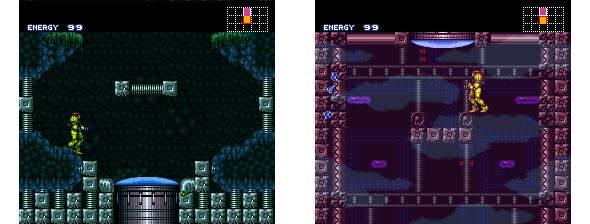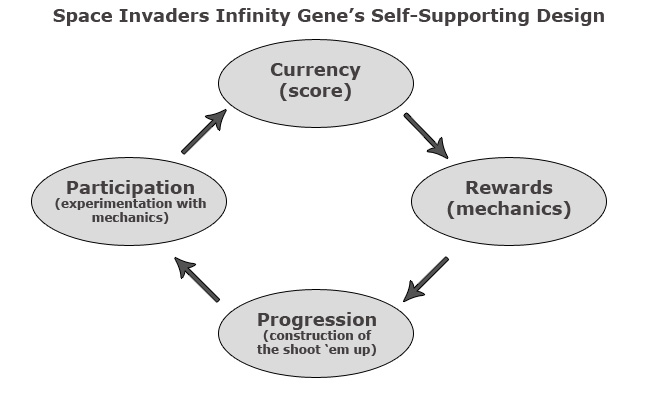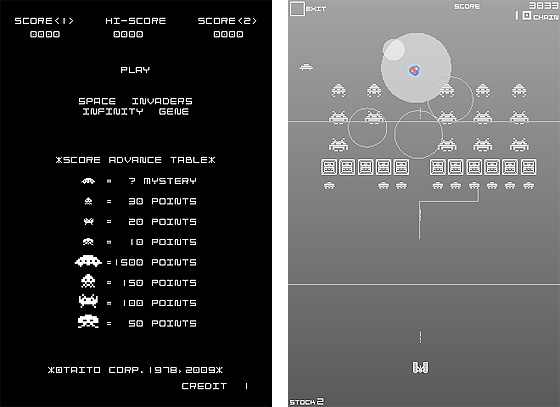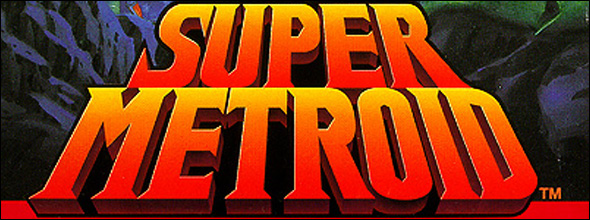Super Metroid – Open-ended Linearity
August 31st, 2010
The original Metroid has a defining flaw that would later be rectified with its successor, Super Metroid. The open-ended environments are a composition of arbitrarily posted tile sets with little sense of direction. To put it frankly, the desolate planet Zebes is a maze. As a result, there’s a certain sense of dread you often feel when playing Metroid, as it’s very easy to lead yourself astray in the oxygen-less solitude and find yourself boxed in against an insurmountable tangle of similarly-looking tiles. Super Metroid avoids the confusion by providing sufficient scaffolding to lead players along without arousing their suspicion that the experience Super Metroid offers is a well managed, staged affair. In this way, it fools the player into discovering things for themselves, when in fact our exploration is preordained, and we love it all the more for it.
Let’s take a squiz at how exactly Super Metroid appears more open-ended than it actually is. Super Metroid utilizes the SR388 overworld as a hub which connects the player to the various planetary sub-sections. Overworlds are often interpreted as de-linearating a game and offering player choice, even though oftentimes they afford no such freedoms.Super Metroid‘s overworld is a guise. Players are free to search for and enter SR388’s separate domains before the game requires them to, but on stumbling upon Brinstar, Norfair or Maridia the player quickly realizes that their progress is limited by their current selection of power-ups. In this sense, the player’s sphere of progression is not tied to the seemingly open world, but to the power suit. Therefore, the limitations enforced upon the player are not presented in a way which can be translated into tangible areas of the map, by which, the player cannot properly understand what is or isn’t within their reach. The only way that they can find out is by looking for themselves. Not only does this unknown (but never hidden) factor liberate the player’s sense of exploration, but it also persuades them to gain their own bearings of the world through actual exploration. The map is therefore a clever aid in the exploration process, since it does provide that tangible reinforcement to the player.
The individual chunks of terrain that break away to your power-ups are doorways masked as environmental puzzles, where the power-ups themselves are switches that activate the opening of doors. When a player acquires a new power-up in Super Metroid, several gates are open. Of course, Super Metroid is still linear since the gates that lead to to the next major power-up (and so on until the end of the game) are pre-determined; all players will walk the same rough path. However, Super Metroid hides this very fact in three ways. Firstly, the player may take their own route to the next mandatory gateway. Secondly, when a power-up is gained, it opens the potential for the player to access peripheral weapon upgrades (which increases the number of items held), think of them as secondary doors. And lastly, on occasion, there is more than one mandatory gateway that leads the player to the next power-up; since there is some choice, this is thereby not linear. As you can see, it’s all effectively linear, but it’s mapped around a system of diversion. No first time player will stumble upon the perfect combination of clues to lead them linearly to the end of the game. Players will inevitably be de-routed, and on their way, stumble into weapon upgrades, dead ends, previously explored areas, and walk in circles; all are tricks to create a false sense of freedom.
So, the real meat of Super Metroid are the power-ups and respective gateways which forward the progression to the end game. These are directive tools which manipulate the player’s progression. And as can be seen, Metroid is highly managed, yet we love Metroid so much because the game tricks us into thinking that we are exploring by ourselves; however, we are exploring within the confines of a mold which is ultimately linear and intentional.
Space Invaders: Infinity Gene – Construction of the Shoot ’em Up
August 28th, 2010
Since popularising the shoot ’em up in 1978, the Space Invaders series practically went dormant for thirty years. Sure, Taito rolled out sequels and anniversary editions, but rarely did these games evolve the series in any meaningfully sufficient way. Such thinly-veiled cash-ins on the Space Invaders namesake could barely meet the legacy they were supposedly representing. The series’ presence in modern gaming was an embarrassment, to be sure. In recent years though, with the release of Space Invaders Extreme and its sequel, Taito have done good on one of gaming’s longest surviving brands by doing what they failed to get right before: tampering with the source.
In this light, Space Invaders Infinity Gene isn’t so much an expansion of an already great game like Extreme, but instead a tribute; an interactive construction of Space Invaders‘ legacy: the modern shoot ’em up. And it all begins from stage one, the original Space Invaders, before moving into progressively more contemporary territory.
Like most age-old shoot ’em ups, in Infinity Gene, the player increases their score through a combo system. However, after completing a stage or losing a life, you’re not presented with a high score table, but instead the points earned act as a currency which fill out an evolution meter. Once you’ve maxed out the meter the game “EVOLVES”. Evolving adds one of three things to Infinity Gene: new mechanics, bonus stages or graphic and sound unlocks.
Replaying a level, which you are free to do at any time, will give you another shot at adding more blue juice to the bar. As you progress it becomes harder to score the points necessary to evolve, meaning that repeated plays slowly become a requirement of pushing the mechanical game forward. Yet ideally—and particularly in the later stages—you don’t want to be spending your time replaying the same level repeatedly just to gain an extra inch of blue fill. You do, however, still want to max out the evolution bar since the pay-off for doing so will make life easier by adding new gameplay mechanics. The result is well-crafted baiting, but calling Infinity Gene a game of baiting would be to do the game a great disservice. Points are gained on the grounds of skilfully employing combos and hitting targets (although you can grind if you need to) and the rewards are new tools which feed back into the loop of gaining points. The more points you earn, the more “arms” (shooting techniques) are made available via a selection screen preceding each level, giving the player more applicable options in meeting the challenges of the changing level design. So, experimentations and commitment leads to rewards which foster more experimentation and commitment. By commodifying the traditional points system, Infinity Gene’s gameplay becomes more relevant to regular players (as opposed to high scoreboard chasers) in that it facilitates a system of progression tied to the context of the game (evolution). Of course, high scoreboards are still present for those who wish to pursue them.
Once players make it through the initial comfort stages, Infinity Gene switches up its enemy patterns to suit the different “arms”, persuading the player to first explore with their new tools. Later, experimentation become mandatory as the design moves into a tertiary phase where only certain arms are applicable in defeating the enemy patterns present in each stage. This sort of involving level design which motivates the player to be creative with the tools they are provided with leads back into the currency of points. The more the player understands the various arms, the better off they are for gaining high combos and claiming a better score which they are in-turn rewarded with more tools.
Speaking in the ethos of the game itself, Infinity Gene is a construction, where the player constructs a modern day shmp, piece by piece, through their committal to the scoring system (the very foundation of the arcades, also part of the ethos). In Infinity Gene the means support the ends as can be seen in this diagram:
Now let’s add some squiggly lines:
It’s worth explaining the squiggly lines in the diagram. They are the underlying methods of persuasion used ensure the player remains active within this framework. Firstly, to the far right, persuasion of completism is the human tendency for no stone to be left unturned. This is the reason why Tetris is so addictive, our cerebral matter craves order in a world of clutter. Tetris creates clutter, the player creates order and the two forces create an addictive dynamism. Infinity Gene feeds our obsessive compulsive nature via the user interface of the level select screen. The main levels are mapped out along the spine of an evolution tree with 2 branches possible at either side. Since the player can only evolve once per stage, the interface keenly marks all the evolutions which have yet been reached, enticing the player to correct the apparent mistake.
Secondly, the centre point, the player is made to believe that the game is evolving (even if they themselves are not personally evolving the game very much) through the minor visual details added to each progressive level. Level-to-level, nuance forms around the crusts of the visual design, until a set of stages are completed and the presentation reboots with new colours and effects.
Lastly, as the player progresses, the layout of the levels (which transition from blank emptiness to more structural as you go along) and enemy placements begin to favour a wider variety of “arms”, nudging, and at times forcing, the player to actively use the tools in which they’re unlocking.
A Conclusion on Conclusions
Concluding the analysis here, I can’t help but comment on the most effective part of Infinity Gene: the ending. After building up Space Invaders through the lens of Gradius, R-Type and the bullet hell sub-genre, among others, the game ends, the credits roll and then suspiciously, after the dust settles, a variant of the original Space Invaders loads up with a lone invader rapidly making its descent to the bottom of the screen. Immediately, the tactile feeling reverts back to 1978, you’re power-ups and arms are removed and the game changes completely, leaving you with a sudden point of comparison. This game about evolution devolves to the base value in order for its magnitude to be understood. Personally speaking, the impact felt at this point validates all of the play up to that stage.
Conclusion
Space Invaders: Infinity Gene isn’t trying to make up for 30 years of cruddy ports, but rather it’s a documentation of the shoot ’em up genre during the period of time the self-proclaimed “KING OF GAMES” went intro retirement. Infinity Gene is a successful title, because it takes us on a journey where we meaningfully construct the results of a legacy left abandoned. The guts it takes to do this is commendable, but the execution is even more so.
Super Metroid – Establishing the Doctrine
August 19th, 2010
The original Metroid may not be as sharp as Super Metroid, but it does have one trump over its SNES successor, being its initial assertion of exploration-driven gameplay. A year prior to Metroid‘s release, Super Mario Bros. had taught players that walking to the right-hand side of the screen would advance the game. Metroid, in a master stroke of studio-wide realization and subversion, did the exact opposite: it told players to go left. If the player walked left, instead of the assumed right, at the game’s onset, they would stumble upon Metroid‘s first power-up, the morph-ball, thereby allowing the player to bypass a stumbling block a few screens to the right. As with Super Mario Bros. and that first goomba, the player cannot progress until they have understood the fundamental principles of the game. In one fell swoop, Metroid succinctly communicated its doctrine of subversive exploration.
Super Metroid‘s takes a much less momentous approach but wisely integrates the morph-ball bomb technique, which becomes a crutch for exploration throughout the entire game. Early on in Super Metroid, after the player becomes acquainted with the basic controls, they’re lead through a cavern to a seemingly dead end. They’re as stuck and confused as anyone who’d just been lead down the wrong path would be. After some fumbling about, the player will likely go back to the wall, look around until they notice that at the bottom of the wall is a block with an unsuspecting texture which mildly stands out from the fungus growing around it. A short morph-ball bomb later and—voila!—the block evaporates and the game continues.
Right there, by raising the bar high in this initial instance, Super Metroid doesn’t just set a precedence for exploration but also demands the player learn the tools (morph-ball bomb) and adopt the observation techniques (out of place textures) required to explore properly. As put by co-creator Yoshio Sakamoto in an interview with RetroGamer magazine:
We wanted players to explore everything we’d made and then move on. That’s why we designed the maps in such a way that the player couldn’t escape without exploration, or in such a way that the player would end up back at a starting point before advancing. The player would be cornered/driven and would eventually be forced to stop and say, “Right, how should I think about this area?” That’s the essential point of Metroid’s map design.
Since such a significant chunk of exploration—namely in the first half of the game, but nonetheless throughout—is based around the morph-ball bomb technique, it can be argued that Super Metroid is simply more specific with what it teaches. This makes sense as Super Metroid scaffolds tutorials around the player continuously throughout the experience in the most minute and unnoticeable ways. The original Metroid, on the other hand, sets the player up briefly and then lets them loose on a massive environment with minimal help or suggestion.










 Game Design Companion: A Critical Analysis of Wario Land 4 - $7.99
Game Design Companion: A Critical Analysis of Wario Land 4 - $7.99 Level Design: Processes and Experiences
Level Design: Processes and Experiences Speed Boost: The Hidden Secrets Behind Arcade Racing Design - $5.99
Speed Boost: The Hidden Secrets Behind Arcade Racing Design - $5.99 Adventures in Games Analysis: Volume I - $5.99
Adventures in Games Analysis: Volume I - $5.99







